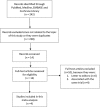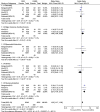Adverse Cardiovascular Outcomes associated with Coronary Artery Bypass Surgery and Percutaneous Coronary Intervention with Everolimus Eluting Stents: A Meta-Analysis
- PMID: 27775055
- PMCID: PMC5075879
- DOI: 10.1038/srep35869
Adverse Cardiovascular Outcomes associated with Coronary Artery Bypass Surgery and Percutaneous Coronary Intervention with Everolimus Eluting Stents: A Meta-Analysis
Abstract
This study aimed to compare the mid-term adverse cardiovascular outcomes associated with Coronary Artery Bypass Surgery (CABG) and Percutaneous Coronary Intervention (PCI) with Everolimus Eluting Stents (EES). Electronic databases were searched for studies comparing the mid-term (>1 year) adverse cardiovascular outcomes between CABG and PCI with EES. Odd Ratios (OR) with 95% Confidence Intervals (CIs) were calculated and the pooled analyses were performed with RevMan 5.3 software. A total number of 5207 patients were involved in this analysis. No significant difference was observed in mortality between CABG and EES with OR: 0.90, 95% CI: 0.73-1.10; P = 0.30. Moreover, CABG was associated with a high stroke rate, with OR: 0.73, 95% CI: 0.45-1.17; P = 0.19, without any statistical significant. CABG was associated with significantly lower Major Adverse Cardiac Events and Myocardial Infarction with OR: 1.46, 95% CI: 1.05-2.04; P = 0.03 and OR: 1.46, 95% CI: 1.01-2.12; P = 0.05 respectively whereas PCI was associated with a significantly higher repeated revascularization with OR: 2.21; 95% CI: 1.76-2.77; P = 0.00001. In conclusion, significant differences were noted in several subgroups analyzing the mid-term cardiovascular outcomes between CABG and EES.
Figures





References
-
- Zheng Z. et al.. Coronary Artery Bypass Graft Surgery and Percutaneous Coronary Interventions in Patients With Unprotected Left Main Coronary Artery Disease. JACC Cardiovasc Interv. 9(11), 1102–1111 (2016). - PubMed
-
- Zhang D. et al.. Coronary Artery Bypass Grafting Versus Percutaneous Coronary Intervention in Patients With Left Ventricular Systolic Dysfunction: A Meta-Analysis. Angiology, pii: 0003319716639197 (2016). - PubMed
-
- Bundhun P. K., Pursun M., Teeluck A. R. & Long M. Y. Are Everolimus-Eluting Stents Associated With Better Clinical Outcomes Compared to Other Drug-Eluting Stents in Patients With Type 2 Diabetes Mellitus? A Systematic Review and Meta-Analysis. Medicine (Baltimore). 95(14), e3276 (2016). - PMC - PubMed
-
- Stone G. W. et al.. Differential clinical responses to everolimus-eluting and Paclitaxel-eluting coronary stents in patients with and without diabetes mellitus. Circulation. 124(8), 893–900 (2011). - PubMed
Publication types
MeSH terms
Substances
LinkOut - more resources
Full Text Sources
Other Literature Sources
Medical
Miscellaneous

